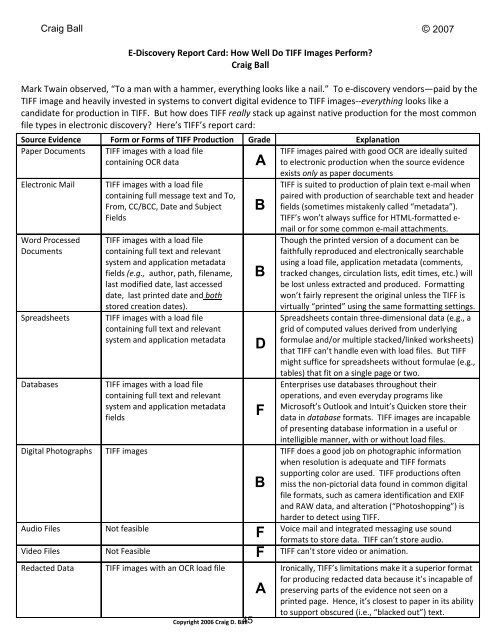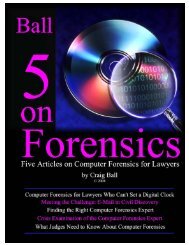Six Articles on Electronic - Craig Ball
Six Articles on Electronic - Craig Ball
Six Articles on Electronic - Craig Ball
You also want an ePaper? Increase the reach of your titles
YUMPU automatically turns print PDFs into web optimized ePapers that Google loves.
<strong>Craig</strong> <strong>Ball</strong> © 2007<br />
E‐Discovery Report Card: How Well Do TIFF Images Perform?<br />
<strong>Craig</strong> <strong>Ball</strong><br />
Mark Twain observed, “To a man with a hammer, everything looks like a nail.” To e‐discovery vendors—paid by the<br />
TIFF image and heavily invested in systems to c<strong>on</strong>vert digital evidence to TIFF images‐‐everything looks like a<br />
candidate for producti<strong>on</strong> in TIFF. But how does TIFF really stack up against native producti<strong>on</strong> for the most comm<strong>on</strong><br />
file types in electr<strong>on</strong>ic discovery? Here’s TIFF’s report card:<br />
Source Evidence Form or Forms of TIFF Producti<strong>on</strong> Grade Explanati<strong>on</strong><br />
Paper Documents TIFF images with a load file<br />
TIFF images paired with good OCR are ideally suited<br />
c<strong>on</strong>taining OCR data<br />
A to electr<strong>on</strong>ic producti<strong>on</strong> when the source evidence<br />
exists <strong>on</strong>ly as paper documents<br />
Electr<strong>on</strong>ic Mail<br />
Word Processed<br />
Documents<br />
Spreadsheets<br />
Databases<br />
Digital Photographs<br />
TIFF images with a load file<br />
c<strong>on</strong>taining full message text and To,<br />
From, CC/BCC, Date and Subject<br />
Fields<br />
TIFF images with a load file<br />
c<strong>on</strong>taining full text and relevant<br />
system and applicati<strong>on</strong> metadata<br />
fields (e.g., author, path, filename,<br />
last modified date, last accessed<br />
date, last printed date and both<br />
stored creati<strong>on</strong> dates).<br />
TIFF images with a load file<br />
c<strong>on</strong>taining full text and relevant<br />
system and applicati<strong>on</strong> metadata<br />
TIFF images with a load file<br />
c<strong>on</strong>taining full text and relevant<br />
system and applicati<strong>on</strong> metadata<br />
fields<br />
TIFF images<br />
45<br />
Copyright 2006 <strong>Craig</strong> D. <strong>Ball</strong><br />
B<br />
B<br />
D<br />
F<br />
B<br />
TIFF is suited to producti<strong>on</strong> of plain text e‐mail when<br />
paired with producti<strong>on</strong> of searchable text and header<br />
fields (sometimes mistakenly called “metadata”).<br />
TIFF’s w<strong>on</strong>’t always suffice for HTML‐formatted e‐<br />
mail or for some comm<strong>on</strong> e‐mail attachments.<br />
Though the printed versi<strong>on</strong> of a document can be<br />
faithfully reproduced and electr<strong>on</strong>ically searchable<br />
using a load file, applicati<strong>on</strong> metadata (comments,<br />
tracked changes, circulati<strong>on</strong> lists, edit times, etc.) will<br />
be lost unless extracted and produced. Formatting<br />
w<strong>on</strong>’t fairly represent the original unless the TIFF is<br />
virtually “printed” using the same formatting settings.<br />
Spreadsheets c<strong>on</strong>tain three‐dimensi<strong>on</strong>al data (e.g., a<br />
grid of computed values derived from underlying<br />
formulae and/or multiple stacked/linked worksheets)<br />
that TIFF can’t handle even with load files. But TIFF<br />
might suffice for spreadsheets without formulae (e.g.,<br />
tables) that fit <strong>on</strong> a single page or two.<br />
Enterprises use databases throughout their<br />
operati<strong>on</strong>s, and even everyday programs like<br />
Microsoft’s Outlook and Intuit’s Quicken store their<br />
data in database formats. TIFF images are incapable<br />
of presenting database informati<strong>on</strong> in a useful or<br />
intelligible manner, with or without load files.<br />
TIFF does a good job <strong>on</strong> photographic informati<strong>on</strong><br />
when resoluti<strong>on</strong> is adequate and TIFF formats<br />
supporting color are used. TIFF producti<strong>on</strong>s often<br />
miss the n<strong>on</strong>‐pictorial data found in comm<strong>on</strong> digital<br />
file formats, such as camera identificati<strong>on</strong> and EXIF<br />
and RAW data, and alterati<strong>on</strong> (“Photoshopping”) is<br />
harder to detect using TIFF.<br />
Audio Files Not feasible Voice mail and integrated messaging use sound<br />
F<br />
formats to store data. TIFF can’t store audio.<br />
Video Files Not Feasible F TIFF can’t store video or animati<strong>on</strong>.<br />
Redacted Data TIFF images with an OCR load file<br />
Ir<strong>on</strong>ically, TIFF’s limitati<strong>on</strong>s make it a superior format<br />
for producing redacted data because it’s incapable of<br />
A preserving parts of the evidence not seen <strong>on</strong> a<br />
printed page. Hence, it’s closest to paper in its ability<br />
to support obscured (i.e., “blacked out”) text.













